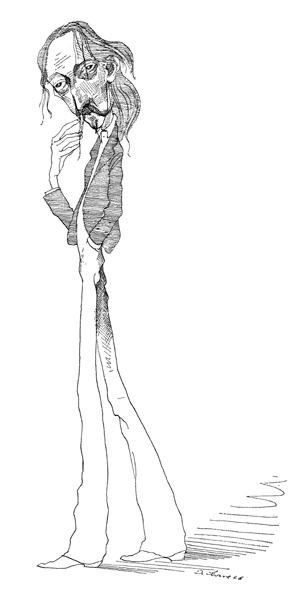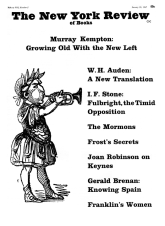When Robert Louis Stevenson died in Samoa at the age of forty-four, in 1894, Henry James wrote, “He lighted up one whole side of the globe, and was in himself a whole province of one’s imagination. We are smaller fry and meaner people without him.” The mutual regard of these two writers, which involved genuine literary admiration as well as personal friendship, may be surprising to the modern reader, who thinks of James as the great luminary of the “serious” novel, while Stevenson is remembered, if at all, simply as a writer of superior children’s books. And yet James was by no means alone in his veneration for Stevenson; there were many similar expressions of desolation at the news of his death, and a widespread opinion that a major literary talent had been prematurely extinguished. In the last few years there has been a slow but noticeable growth of interest in the “minor” writers of the late nineteenth century, and it would be surprising if Stevenson, once so much admired, had not been selected for a fresh assessment. He is fortunate in having found so perceptive a critic as Mr. Kiely to unfold his essential qualities, and to make a case for the mature Stevenson as a serious novelist.
One element in Stevenson’s appeal was, undoubtedly, the irresistibly charming personality that filters through all his earlier writings, and particularly the essays and travel books. It constantly manifests itself in From Scotland to Silverado, a newly edited collection of three of Stevenson’s travel books, The Amateur Emigrant, Across the Plains, and The Silverado Squatters (which restores a substantial amount of material suppressed in earlier editions), together with some previously uncollected essays. The book describes Stevenson’s trip from Glasgow to New York in 1879, which he made in an emigrant ship, followed by a train journey across the United States to California. In Monterey he was reunited with Fanny Osbourne, with whom he had fallen in love in Europe, and they were married in May 1880. The last section is about the rugged but happy summer they spent living at the site of a deserted silver mine in northern California. Stevenson’s charm is always present, ingratiating and at times a little too insistently self-regarding: Mr. Kiely rightly compares Stevenson’s literary persona to a precocious and highly intelligent schoolboy, very much aware of the impression he is creating. Nevertheless, the touch of the born novelist is unmistakable in his account of the voyage. Conditions were exceedingly squalid, but the emigrants kept their spirits up and Stevenson was a fascinated recorder of the odds and ends of drama and human eccentricity that life at sea manifested. He is equally vivid about the transcontinental rail journey, which was still very much an adventure in those days and nearly as uncomfortable as the voyage across the Atlantic.
YET, ENJOYABLE though his travel writings are, it is, ultimately, the novelist in Stevenson who most engages our interest—above all, the author of The Master of Ballantrae and the unfinished Weir of Hermiston. The popular opinion which, from a recollection of childhood reading, sees Stevenson primarily as the author of Treasure Island and Kidnapped is not, of course, wrong: These books are works of genius in their own kind, and remind us of Stevenson’s profound and lifelong commitment to the fiction of adventure. But he was at the same time an extremely conscious and conscientious artist, and it was this aspect of his craft that Henry James so respected; Walter Allen has neatly remarked that Stevenson “successfully married Flaubert to Dumas.” One of the most fascinating parts of Mr. Kiely’s book is the chapter in which he outlines Stevenson’s fictional aesthetic; in the course of doing so he throws out hints that seem to me very relevant to recent developments in the novel. Stevenson combined a quasi-symbolist belief in the self-contained separateness of art, with the conviction that “life” would always be larger and more various than art, and that the novel could never, as James had suggested, hope to compete with life: “Life is monstrous, infinite, illogical, abrupt, and poignant; a work of art, in comparison, is neat, finite, self-contained, rational, flowing and emasculate.” At the same time, art could successfully improve on life by offering vivid images of possibilities that were unattainable in fact; in other words (disapprovingly modern words), by being frankly escapist. Stevenson also claimed, however, that adventure fiction achieves an ultimate universality by reproducing archetypal forms of action: “Thus novels begin to touch not the fine dilettanti but the gross mass of mankind, when they leave off to speak of parlours…and begin to deal with fighting, sailoring, adventure, death or child-birth…These aged things have on them the dew of man’s morning…” Stevenson is implying a view of fiction that is at odds, not only with James, but with virtually all later critics, apart, perhaps, from Chesterton and C.S. Lewis, both of whom were vehement defenders of fictional romance. Mr. Kiely suggestively remarks that for Stevenson—who once wrote, “It is a better thing to travel hopefully than to arrive”—“process becomes its own goal.” Here, and in Stevenson’s conviction that the heroes of adventure stories should not be too fully realized since too much personality might affect our involvement with the action, we are close to the characteristic procedures of TV serials, magazine fiction, or the comic strip. Certain tenuous but genuine lines of descent can be traced, since Stevenson leads directly to John Buchan, who points the way to the adventures of that deracinated Scotsman, James Bond. And with the current vogue of pop culture, which means that serious novels are adopting, by a kind of feedback effect, the techniques of the comic strip, Stevenson’s principles of fiction might prove useful in taking bearings on works that the hallowed post-Jamesian categories can do nothing with. Mr. Kiely is certainly aware of the revolutionary implication of the Stevensonian aesthetic of adventure, but is a little timid about making full critical use of it. If he praises The Master of Ballantrae and Weir it is because they offer more than simple adventure: a real depth and complexity of feeling, psychological interest, and, for the first time in Stevenson’s fiction, a mature sexual awareness.
Advertisement
IF MR. KIELY doesn’t follow up all the implications of his treatment, he is, nevertheless, a highly professional critic, whose lucid and tactful performance is a model of how these things should be done. He has all the appropriate tools and knows how and when to use them; thus he will move easily from the analysis of imagery to the use of biographical material, and thence to, say, glancing at mythic patterns in the manner of Frye or Fiedler. Where he is, I think, a little weak is in not giving sufficient weight to Stevenson’s Scottishness. The truth about Scotland is that it is not an inferior northern appendage to England, though the English often regard it as such, but a separate country, which is different from England in much more than landscape; its history, romantic, bloody, and uniformly tragic, is more reminiscent of an East European nation. It was this exotic quality that Stevenson distilled so finely, particularly in the late novels that he wrote out of an imagination brooding on his native land from the other side of the globe; the rainy moorland and the gray stones of Edinburgh were never more real to him than in the sun of the South Seas.
Mr. Kiely is right to play down Stevenson’s obvious debt to Scott, but there are other antecedents he might have allowed for. He remarks:
In Jekyll and Hyde…Stevenson probes the Calvinist tradition of personified evil largely for Gothic effect. Much as he came to despise the moral rigidity of his religious heritage, he remained throughout his life enchanted by its atmosphere—the damp chapels and bleak kirkyards, the dour believers, the darkness and devilry.
This is undoubtedly true; but Mr. Kiely does not tell us whether Stevenson knew or was influenced by, that small masterpiece of Calvinist Gothic, James Hogg’s Confessions of a Justified Sinner. The interest in evil and in duality that Stevenson gave famous expression to in Jekyll and Hyde is more fully and seriously developed in The Master of Ballantrae, which Henry James described as “a pure hard crystal, my boy, a work of ineffable and exquisite art.” At the risk of descending into a parochial modernism, one must say that there are elements about it that are very much of our own times. The technique is of an assured sophistication, and involves us with that familiar topic in recent novel-criticism, the problem of the unreliable narrator. Our knowledge of the Master and his younger brother Henry is mostly derived from the narrative of the old servant Mackellar, and, as Mr. Kiely puts it, his “effort to describe Ballantrae is like an inadequate attempt to catalogue a new species.” In the relationship between the energetic and Satanic Master and his brother, dull and decent at first, but increasingly corrupted, we have an embodiment of the Doppelgänger theme that anticipates many of the characteristic concerns of twentieth-century literature. Mr. Kiely’s treatment of the novel is generally illuminating, but I think he makes a crucial misreading of it in one respect. He suggests that Ballantrae fits into a line of literary descent deriving from Milton’s Satan, and including such nineteenth-century representatives as Manfred, Rochester, and Heathcliff, whose vices are in large measure balanced by the positiveness of their energy. Mr. Kiely is dismissive about Ballantrae’s sins, implying that they consist in little more than drinking, wenching, flirting with his brother’s wife, and constantly extorting money from him. But he misses the point that the blackest mark against the Master is that he is a traitor to the Jacobite cause; and treachery, for which Dante placed sinners in the lowest circle of Hell, is hardly to be regarded so lightly. It seems to me that in some ways Mr. Kiely reduces The Master of Ballantrae by giving insufficient weight to the Master’s absolute evil, which is something more than merely Gothic or melodramatic. If the pattern is a little less clear than Mr. Kiely implies, then that is surely to Stevenson’s advantage; this remarkable novel shows its author’s long allegiance to the fiction of adventure, and is yet subtler, richer, and harder to define. As Mr. Kiely remarks, it shows a curious progress from the historical and epical to the individual until the two brothers, at the end of the novel, are buried in the same grave. With Weir of Hermiston, which is a fragment merely, we have moved entirely beyond adventure, and the wonderful, Rembrandtesque figure of the Justice-Clerk, Adam Weir, illustrates the power of realizing character that Stevenson came to possess by the end of his life.
Advertisement
This Issue
January 26, 1967




